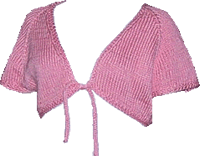Mary Ann Raglan
Inspired by attire worn by "Mary Ann" from Gilligan's Island.Hand knit sweater pattern by Lucia Liljegren, The Knitting Fiend.
AKA: Seamless raglan sweater, hand knit top down. Knitting completed April 15, 2005. (Note: I will be refining this code to knit a full size sweater. This sweater captures all the "hard part" of calculating a sweater top down. In a month or so, I'll have the button front raglan knit top down.)
If you like raglan sweaters, you'll probably want to see my Husband Sweater, or Ball Game Sweater, which which are knit from the bottom up. Other sweater styles are illustrated at my sweater pattern index page. Get updates about my new patterns and generators at The Knitting Fiend blog.

Here is a list of features available with this generator:
- The toggles are preset for the style and size
shown.
- As always, you enter your stitch and row gauge. You
can knit out of any yarn weight, from fingering to chunky.
- Shape: Raglan bolero pull over knit top to bottom.
- Sleeves: These sleeves are 1 row of stockinette and a few rows of garter stitch. I don't let you change that yet.
- Length: I let you change the length, but I strongly advise
not making this longer than waist length using this code.
- Neck: V neck, just slightly less deep than the armholes.
- The yarn estimator is set to stockinette. You can change
that to Broken
Rib Stitch.
- The size is set to Woman's size 8. You can change that to
Women's
2-22
- Garter stitch cuffs and hem.
- It's free. Of course, you can donate to maintain the site.
- Click this pop up pattern button to get your pattern. (I advise clicking it now. Really.)
- If the window doesn't pop up, scroll to the bottom and read
the final instructions about pop-up windows.
- This pattern generator is a program that creates a pattern. If you want to customize for your size, your yarn or anything else, click the go-away box on the pattern window that popped up. Then, scroll down, and make changes. Then click any the pop-up window button you find on this page. opening. That will create your customized pattern.
- 4 100 gram skeins of Sinfonia mercerized cotton,
knit double stranded. I bought mine at Hobby-Lobby in
Naperville. I knit mine double stranded with size 9 needles and
got a gauge of about 3.5 stitches per inch. It shrunk
approximately 8% when I washed it; so do remember to measure before and
after you wash your swatch.
- Denise
circular needles with size 9 tips attached for main
stitch and size 7 for trim. This let me change the length of the
cable. It needs to be very long when you put all the stitches on
the yoke; smaller is better when you knit the top of the sleeves.
- Tapestry needle to weave in ends.
- A crochet hook to fix occasional mistakes.
- Women's size 8.
- Using yarn double stranded. Using yarn double stranded often saves money because you have more yarns to select from.
- Paired increases for a raglan; this shows how to work the 'M1' increases so the raglan line is decorative and beautiful.
- Dividing
for the body; this just shows how the sleeve stitches are put on
strings.
- Increasing stitches at the underarm.
If you do it this way, it's really easy, and you don't need to seam
later.
- Decreasing evenly across rows. (This is a calculator. You will probably want to decrease stitches this at the hem.)
- Short
rows at the hem of the sweater. I knit these to make the back
longer than the front. Busty gals can do the opposite and make the
front longer than the back.
- Knitting i-cord (idiot cord).